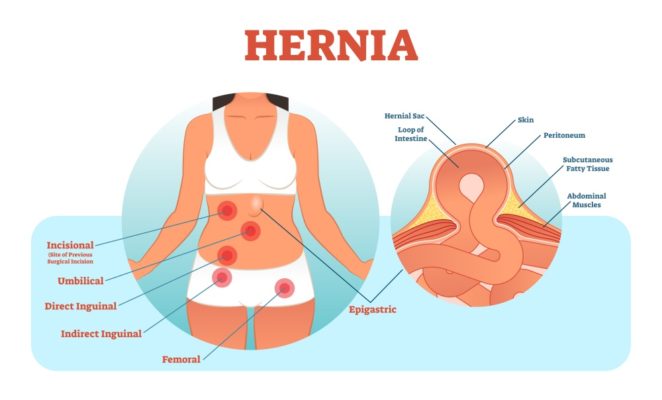
Hernias are weak spots or tears in the abdominal wall muscles, through which abdominal organs or fat may bulge out under the skin. In the same way that an inner tube pushes through a damaged tire, the inner lining of the abdomen pushes through the weakened area of the abdominal wall to form a small bulging balloon (hernia sac). With smaller hernia defects, the bulge is not initially visible, but patients may experience pain in the area of concern. If left untreated, hernias do not resolve on their own, and they generally become larger or more painful. Although most hernias are not dangerous, life-threatening complications may occur, such as intestinal blockage or strangulation.
Hernias can be located anywhere on the abdominal wall: in the groin (inguinal hernias), belly button (umbilical hernias), at the site of a previous surgical scar (incisional hernias) or even the back. Conversely, some hernias are “internal” and never present with a bulge. Such is the case with hiatal hernias, in which the stomach slides into the chest cavity through a defect in the diaphragm, leading to symptoms of gastro-esophageal reflux disease, chest pain or inability to eat.
Inguinal Hernia
Located in the groin region, this is the most common type of hernia. Robotic and laparoscopic repairs are equally effective and help speed up recovery when compared with the traditional open approach.
Incisional Hernia
Located at the site of a previous abdominal operation. Most can be repaired robotically or laparoscopically, with great outcomes and minimal pain.
Ventral Hernia
Located anywhere on the abdominal wall, typically in the absence of a previous operation at that specific location.
Abdominal Wall Reconstruction
This technique is employed for very large abdominal wall hernias, in which muscles need to be mobilized towards the midline in order to allow restoration of the normal anatomy and restore the function of the abdominal wall. Most cases are approached robotically, however some may require an open operation due to severity of adhesions or large size of the hernia.
Umbilical Hernia
Located at the level of belly button, they are generally present since birth, but may become obvious later in life, sometimes with precipitating events. Small hernias may be repaired in open fashion, while larger one generally require a laparoscopic or robotic approach with mesh.
Chronic Groin Pain
Patients who underwent open or laparoscopic inguinal hernia repairs can sometimes experience groin pain for months or years after the operation. This could be related to a hernia recurrence, nerve injury, or secondary to the previously placed mesh or fixation device. In selected cases, mesh removal may be beneficial in improving patients’ quality of life.
Diastasis Recti
Patients with diastasis recti may present with a bulge or “crease”, generally above the belly button. This condition is due to weakening of the midline fascia (the tissue connecting the two rectus abdominis muscles – the “six-packs”) and is not a true hernia (a hole in the muscle). It is more common after pregnancy, but it may also happen in men, particularly when associated with weight gain. Core strengthening exercises and maintenance of a health weight are the mainstay of treatment. Surgical options can be employed in certain cases, either through open or minimally invasive approaches.
Hiatal Hernia
They are “internal” hernias, secondary to enlargement of the esophageal hiatus (an opening into the diaphragm muscle, which allows passage of the esophagus from the chest into the abdomen). Consequently, part of the stomach slides up into the chest cavity. They are usually associated with reflux disease.
Morgagni Hernia and Bochdalek Hernia
Rare congenital entities, these hernias represent defects in the diaphragm, the muscle that separates the chest from the abdominal cavity. When present, intraabdominal organs may protrude into the chest cavity through the hernia defects.
